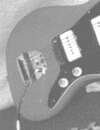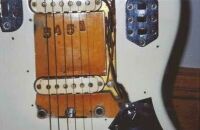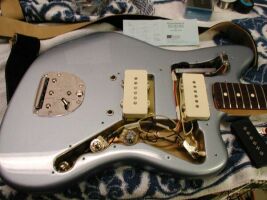TECHNICAL Q & A
What's with the extra switch and knobs above the strings?
The Jazzmaster and Jaguar both provide the player with two separate circuits. The lead circuit
is the standard volume and tone knobs and pickup selector (toggle on the Jazzmaster, switches on the Jaguar)
below the strings. The rhythm circuit uses only the neck pickup, and has its own volume and tone
controls, the two roller knobs above the strings. The switch above the strings selects the circuit being
used: up for rhythm, and down for lead.
What's the sliding knob on the tremolo for?
This is called the "trem-loc" feature. It provides a way to stablize tuning if a string breaks. The "off"
position is towards the bridge. The "on" position is away from the bridge. To set up the trem-loc,
slide the knob away from the bridge, and make sure that it goes under the tremolo plate. (The arm will not
move up, only down) Turn the set screw directly behind the knob until the knob can just start to slide freely
forward
and back. Re-tune the guitar. Repeat the process until the knob can slide freely when the guitar is in
tune.
How does the floating tremolo work, anyway?
The basic principle is the same as a Bigsby vibrato - a single spring
attached to the string end plate holds the guitar in tune. Pushing down
on the spring via the tremolo arm lowers the pitch, and pulling up
increases the pitch. For a diagram of the inner workings of the
floating tremolo and pictures of tremolo hardware, click here.
I'd really like to install a mute on my re-issue Jaguar. How do I do it?
If you've got a handle on basic woodworking, and like to tinker, it is certainly possible to do.
I've personally installed mutes on a MIJ Jaguar and my kustom Jazzmaster - more on this below.
Since a picture tells a thousand words, have a look here for the details.
What do the three switches on the lower bout of my Jaguar do?
These three switches are part of the lead circuit. Starting from the neck side, they are: 1) neck pickup
on/off selector. 2) bridge pickup on/off selector. 3) low end filter "thin" switch on/off.
How is my guitar wired?
The Jazzmaster and Jaguar share a unique wiring circuit developed by Forrest White and Leo Fender that
allows for the player to have two preset volume and tone settings and to change between them by flipping
a switch. For an image of the schematics, click here.
 The bridge rattles and the strings slide around. How do I stop this?
The bridge rattles and the strings slide around. How do I stop this?
First, try heavier gauge strings. Heck, slap on some flatwounds while you're at it! Otherwise, you
want to increase the string angle over the bridge. There's a neat device called a "buzz-stop" that
bolts onto the tremolo faceplate. The Buzz-Stop can be found at a number of on-line guitar parts venders.
Use your favorite search engine to look for them. Feeling adventurous? You can make a simple buzz-stop
type device yourself. Take a length of brass pipe long enough
to cover the tremolo face at the middle
set of mounting screws. Drill holes through the pipe for these
screws, and use them to press down on
the strings. (see figure)
Another technique is to increase the bridge height. You can do this and
keep low action by putting a small shim, such as a guitar pick, under the
butt of the neck in the neck pocket.
The bridge rattles and the saddles lower by themselves. What to I do?
This is easily remedied with some liquid lockwasher from the local hardware store. Put some lockwasher on
the set screws for each saddle, and set it up to the height you want. In about ten minutes, the lockwasher
will dry in place, immobilizing the set screws. Don't worry, a little
force will set them loose again if
you need to adjust the height later.
What's the sequence of cosmetic changes to the guitars?
When introduced in 1958, the Jazzmaster had a rosewood slab fretboard,
clay fret markers, Kluson Deluxe tuners,
and a gold anodized pickguard. The
lead circuit volume and tone knobs were the same as those used on the
Stratocaster. The headstock was larger than that of the Stratocaster,
and the decal used a spagetti logo with
"swoosh lines" at both ends.
The pickguard was switched to tortoise shell plastic by 1959 as the gold
had been wearing off the earlier types. A white pickguard was used on
most custom color models. In 1962,
the fretboards were switched from a
slab to a veneer of rosewood over the maple neck.
The period from 1964 to 1966 was a time of great transition for the
Fender company. Sales were exploding,
and in 1965, CBS bought the
company from Leo Fender, which would soon turn the company on its head.
During this time, many small cosmetic changes were made to Fender
guitars. Pearl dot inlays were introduced
in 1964.
1965 brought neck binding to the Jaguar and Jazzmaster (also the Jazz
Bass and Bass VI), and the Jazzmaster got new, larger chrome-top control
knobs that look like a white version of the blackface amplifier knobs.
The Jaguar had introduced the new thick-letter logo in 1962, and in 1965,
the new logo replaced the spagetti type "Fender" logo on all guitars.
Also, pearloid pickguards were now available on the Jaguar.
In 1966, the pearl dot inlays were replaced with large pearloid block
inlays. Also in 1966, the Jazzmaster and Jaguar received new, even
larger headstocks that had been introduced on the Stratocaster in
1965, and new tuning pegs with "F" stamps and distinct "squat octogon"
shaped
pegheads. Late in 1966, the Jazzmaster headstock decal lost its "swoosh
lines" and gained large block lettering for the model name, similar
to that used on the Jaguar since its inception.
In 1968, Fender switched from nitrocellulose lacquer to a polyester
lacquer. For the first few years it was relatively thin, but became very
thick in the seventies. During the seventies, Jazzmasters and Jaguars
were available with maple fretboards with black plastic inlays, in
addition to the standard rosewood with pearloid inlays. Also, by 1973
tortoise shell pickguards were replaced with black pickguards.
My guitar only says "Fender" on the headstock. Is this stock?
Fender custom color guitars often had headstocks painted to match the body color.
In the case of guitars painted black, Fender apparently decided to use only the gold "Fender"
logo on the headstock, as the remainder is printed in black, and wouldn't be visible.
Black appears to be the only color where this was done.
I think my guitar has a factory re-finish. How can I tell for sure?
 The Fender factory did some refinishes. The bodies were stamped underneath
the pickguard so that they could be tracked through the process. At the right
is a picture of a Jaguar body that received a factory refinish in sunburst, and
later received a non-professional refinish again in white.
The Fender factory did some refinishes. The bodies were stamped underneath
the pickguard so that they could be tracked through the process. At the right
is a picture of a Jaguar body that received a factory refinish in sunburst, and
later received a non-professional refinish again in white.
What's the difference between the old Jazzmasters and Jaguars and the
Japanese re-issues?
First off, it is important to note that the Japanese Jazzmasters and Jaguars
are *not* re-issues. While they carry the basic design of the original
series guitars, they are not intended to be slavish recreations. Fender
called them "Collectibles" and "remakes" which is a fair enough assessment.
I'd say they got it about 75% correct to the old guitars. The main
difference is the body wood.
The old guitars are made of alder or ash, and the new ones are basswood.
Sonicly, the new basswood bodies seems to be a bit brighter, but some of
that could be due to the effect of age on the old guitars.
Interestingly, the reissue Bass VIs have alder bodies. Otherwise, the
necks of the new guitars seem thinner than most old guitars I've seen.
Personally, I greatly prefer the thicker necks!
On a more minor scale, the tremolo springs on
the new guitars are not
strong enough to handle strings of gauge 12 or heavier. Expect a reduced
range of travel unless you get a stiffer spring. The new guitars
don't come with bridge covers and
the Jaguars don't
have mutes, though most people seem to take them off the old guitars
anyway. I
personally installed a mute in a friend's re-issue Jag; it
took about three or four hours.
The re-issue bridge saddles have also been redesigned. The old saddles
were essentially identical
for each string; the new saddles are grooved to
different
depths for each string. Like the rest of
the hardware, the allen screws
are metric, so your old key won't work! Also, the electronics are done
with medium quality components: plastic wrapped wire and stock type
capacitors, potentiometers and switches,
as opposed to the cloth wrapped
wire, high quality potentiometers and Switchcraft switches and jacks used on
the old guitars.
Perhaps the strangest difference between new and old guitars are the
reissue Jazzmaster pickups. For some reason, the Fender company decided
to veer from the original design here.
The original Jazzmaster pickups
have a shallow and wide coil winding. This allows the pickup to sample a
wider area of the string and provides a thick tone. The reissue
Jazzmaster pickups have narrow and deep coil
windings, like a Strat or
Jaguar. These pickups sound relatively thin, and much more like a Strat
or a Jaguar
than old Jazzmasters. Fortunately, Seymour Duncan makes
excellent replacement pickups for the Jazzmaster that
are reasonably
priced (~$60US)
and are built to the same specifications as the old
Jazzmaster pickups.
These really nail the vintage tone.
What color schemes have been available on the Japanese reissue guitars?
There were six color schemes available during the production run of the Japanese
Jazzmaster and Jaguar bought to the United States. There have been four "standard" series colors:
sunburst, sunburst with foto-flame,
candy apple red with matching headstock,
and olympic white.
These guitars have chrome hardware.
The sunburst and white guitars have
tortoise shell pickguards and the red guitars have white pickguards.
In addition to the standard series there
have been two "limited edition"
series: the first was blonde with gold hardware, and
the second, only available from Guitar Center stores, was black with
matching headstock and gold hardware,
but these are very uncommon.
In 2003-2004, Musician's Friend had a limited run of candy apple red and
lake placid blue Jazzmasters and Jaguars available in the US.
More recently, Fender Japan has started making Jaguars and Jazzmasters with
block markers and neck binding, similar to the '66 - '80 vintage models.
Note that the headstock shape remains the same as on the standard '62 style
guitars.
Are MIJ guitars still available in the US?
The Fender company has stopped importing the MIJ Jaguars and Jazzmasters in favor of the MIA models.
However, Fender Japan still makes Jaguars and Jazzmasters. From what I've heard, these guitars are made to
a higher standard than the instruments built for import, with better body woods and electronics. I cannot confirm this
as I have not seen any of these personally.
Apparently, it is possible for the individual consumer to contact Fender Japan to purchase one of these guitars.
Several people on the Fender Forum Jaguar and Jazzmaster forum have
done so.
So, what's the scoop on the new, US-made Jazzmasters and Jaguars?
I am the proud owner of a 2003 sunburst Jaguar. It is a very nice
guitar. The fit and finish is superb, and the tone is classic
Jaguar. I've had the chance to play a couple other Jaguars and
Jazzmasters, and I've been impressed with them all.
The US guitars are made to the same specification as the original sixties models, using same body wood and
the same pickups. The hardware is the same as the originals, with the exception of the tuning pegs, which
are modern recreations of the Kluson safety-post units used in the sixties. The finish is the correct
nitro-cellulose. The available colors at first release in 2000 were sunburst, olympic white, black, candy apple red,
fiesta red, and sherwood green metallic. In 2001, the candy apple red, fiesta red and sherwood green metallic were
dropped in favor of inca silver, dakota red and ice blue metallic.
 At the right is an example of an ice blue metallic US Vintage Reissue Jazzmaster with the pickguard removed.
Note the color coded wires, and the brass cavity shields. Photograph courtesy of Curt Branum.
At the right is an example of an ice blue metallic US Vintage Reissue Jazzmaster with the pickguard removed.
Note the color coded wires, and the brass cavity shields. Photograph courtesy of Curt Branum.
What is the VENTURES model Jazzmaster?
Back in the early sixties, the Fender-toting Ventures turned on a whole
generation of kids to electric guitar
with their catchy twist-based
instrumental guitar music, starting off with their hit version of Johnny
Smith's "Walk - Don't Run." They were most often seen with Jazzmaster
guitars. By the mid sixties, the
group had switched to Mosrite guitars,
and later on to other brands, but recently have returned to Fender
guitars. In fact, both Bob Bogle and Don Wilson have stated in
interviews that the Jazzmaster is their favorite
guitar.
To celebrate and honor this amazing group, the Fender company built a
limited edition run of
Ventures model instruments - a Jazz Bass, a
Stratocaster, and a Jazzmaster. All models feature a
"midnight burst"
finish with matching headstock, pearloid pickguards, block inlays on the
neck and gold
hardware.
The Jazzmaster is a unique instrument and features design suggests made
by the Ventures.
The guitar has Seymour Duncan vintage pickups, a nice
thick neck, and no rhythm circuit. The guitars were
built in a limited run and are no longer in production.
Want to see more about the Ventures and Jazzmasters? Go to Hideki's
Jazzmaster Freak's
Page
What the heck is a Jagmaster? Or a Jagstang for that matter?
Since the alternative music explosion, with its interest in Jazzmasters
and Jaguars,
Fender has introduced several new models loosely based on
these. Basicly, these new guitars
match the offset waist bodies of the
Jag and Jazzmaster with thin modern necks and humbucking
pickups. First was
the JagStang, designed by Kurt Cobain. The model has features of the
Jaguar
and the Mustang. It has one single coil pickup and one humbucker,
and a Mustang dynamic tremolo.
Several years ago, Fender introduced two new guitars through
their Squier brand based on the Jag and Jazzmaster.
The Jagmaster uses a
Jazzmaster body, two humbuckers and a Strat style tremolo. The Super
Sonic is a
mildly cut down, upside-down Jaguar body with two humbuckers,
a Strat style tremolo and a reverse
headstock neck. Neither guitar has
the classic rhythm/lead circuit of the Jaguar and Jazzmaster.
On the bright side, these guitars will hopefully save real Jazzmasters
and Jaguars from getting cut
up and having humbuckers thrown in. In an
interesting turn, these guitars, which appear to be designed
for the
grunge crowd, have been used by instrumental kings Los Straitjackets. It
just goes to show,
what can cross over one way and cross the other as
well.
What are the Cyclone and Toronado?
These guitars are the latest in the line of Jazzmaster and Jaguar "inspired" guitars.
The Cyclone is pretty much a Jagstang with a Mustang shaped body and a Strat style tremolo.
The Toronado is a more interesting departure. It features a less offset variation on the
Jazzmaster body, with two chrome covered humbucking pickups and no tremolo. Both of the guitars
are interesting in their own right, and will probably be popular with those who are more interested
in the styling of the Jazzmaster and Jaguar than the particular sounds these guitars are known for.
Got other questions? E-mail Los Mel and he'll get back to you.